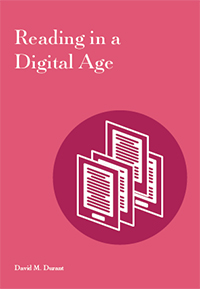
Reading in a Digital Age
Skip other details (including permanent urls, DOI, citation information): This work is licensed under a Creative Commons Attribution-NonCommercial-NoDerivatives 4.0 International License. Please contact [email protected] to use this work in a way not covered by the license.
For more information, read Michigan Publishing's access and usage policy.
Introduction
How we read has dramatically changed with the advent of the digital age. Just twenty years ago, we still primarily read items in print format: books, magazines, newspapers, and academic journals. Now in the web environment, our reading options have enormously expanded: web pages, blogs, tweets, Facebook posts, texts, e-mails, and e-books. In the words of Canadian librarian Barry W. Cull, “The Internet is a text-saturated world. It could only have succeeded in a highly literate society.”[1]
At first glance, this shift would suggest that reading is thriving like never before in the twenty-first century. After all, more texts—from tweets to full monographs—are now accessible to more people than ever before. Yet in recent years, numerous authors, both popular and scholarly, have written books and articles expressing deep concern about the impact of e-reading on our ability to read, write, and even think. I myself have expressed these concerns in my own writings.[2] Others, who champion the transition to digital reading, believe that any costs in terms of literacy will be minimal or may even prove to be net gains.
So why has the future of reading, and digital reading in particular, become such a tremendous source of controversy? This briefing will explore the arguments regarding the nature and consequences of reading in the digital environment. It will also examine some of the key scientific studies analyzing the potential differences between print and digital reading as well as comparative sales trends and surveys of reader behavior and preferences. Are we truly headed for a mostly digital reading environment? Will print make a resurgence? Or will there be a hybrid multiformat reading future? Finally, I will consider the key question: How do we, as librarians, publishers, and software creators, work to preserve reading in all its richness in the digital age?
Before answering these questions, though, the first order of business is to step back and think about reading in general.
One point worth noting as I begin is that this briefing focuses primarily on North America and Western Europe. This is where digital reading has made the greatest strides and where the debate over the future of reading is being waged most earnestly. Thus I focus my attentions here for purposes of clarity and brevity. The state of reading in other parts of the world will inevitably be shaped by the unique factors of each region. While I believe this briefing will be relevant to readers from those areas as well, these distinctions are worth keeping in mind.


